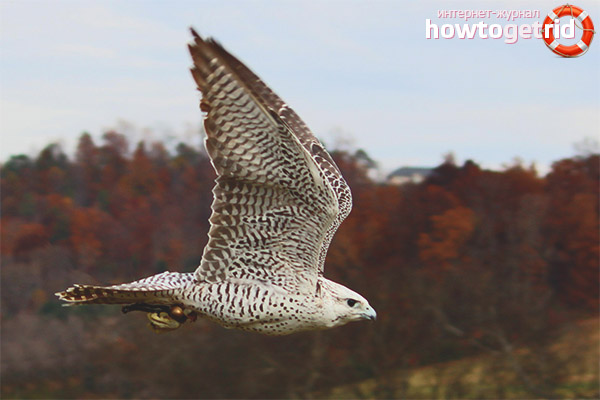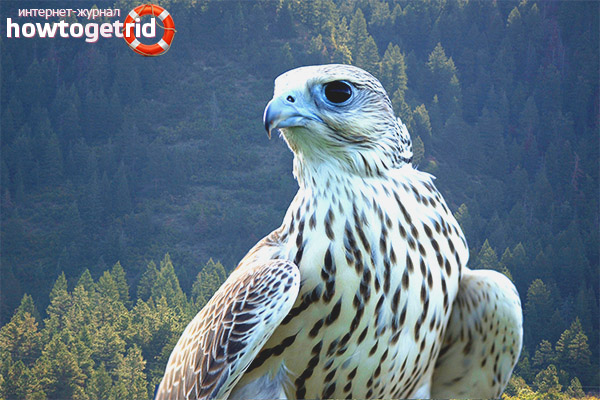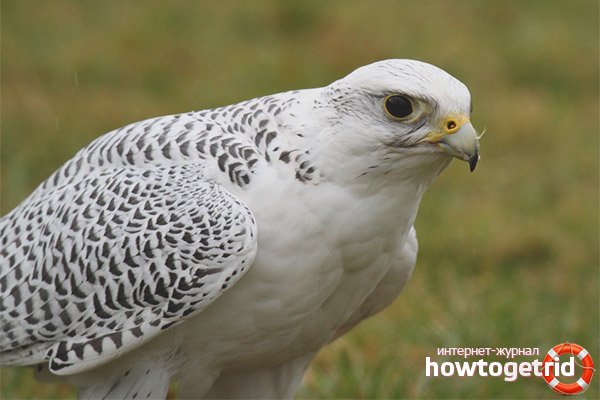The content of the article
The gyrfalcon is a large bird of prey of the Falcon family. The first mention of it dates back to the 12th century. It is assumed that the name of the species was given due to the characteristic singing.
The northern bird is a wonderful hunter, so people tame gyrfalcons and select it in the fields. The large size and ability to develop speed make it an invaluable aid in hunting wild birds.
Description and types
The overall physique of the bird is quite massive and powerful, which allows it to develop good speed without losing aerodynamics. The wings of the gyrfalcon are elongated and pointed, the tail is elongated.
The shade of feathers in females and males is the same. The plumage of birds in the northern habitat has a light shade (grayish-brown on the back). The belly of the representatives is white with a characteristic dark mark. Around the beak is a dark mark that looks like a mustache. A clove characteristic of the falcon family is seen above the beak. Feet are yellow. The plumage of the birds of the southern range is darker, with rich gray and brown tones.
Depending on the habitat and color of plumage, the following types of gyrfalcons are distinguished:
- reds;
- Norwegian (ordinary gray);
- snowy (white), which are considered the most rare and valuable;
- Icelandic.
Lifestyle & Distribution
Gyrfalcon, as a representative of falcons, hunts similarly - flies up to prey from above, gathers wings together and clings to it with powerful clawed legs. If the victim is defending, then the bird kills her with a heavy beak, bites her head or crushes her neck. Then it plucks the prey and eats it, having previously landed not far from the masonry or the place of wintering. Studying the area around the nests of gyrfalcons, one can often stumble upon the remains of the skin, wool, feathers, skeleton, etc. The masonry itself remains clean. Even prey caught to feed the chicks is fed to him already plucked, cleaned of bones, head and limbs.
The main prey for gyrfalcon are flying medium and small birds. In some cases, mammals also appear on the menu. The daily diet of a falcon representative includes about two hundred grams of live food.
Gyrfalcons hunt mainly on their own, like all members of the family. During the nesting period, the predator is not far from the partner.
It flies very maneuverable and fast, with acceleration, preferring not to soar and not to hang in the air. For a powerful start to the bird, it is enough to perform several large strokes. During the rest period, the gyrfalcon sits proudly and directly, carefully monitoring the surrounding area with his head.
Hunting areas intersect with the area of the settlement of polar owls.
Gyrfalcon gives voice willingly - it resembles the trunks of a peregrine falcon, only more coarse and low-frequency. Hunters describe the sound as a hoarse combination of “kyak-kyak” or a long “keeeeek”. In spring, you can hear the gyrfalcon taking higher and calmer trills (chirping).
Mostly representatives of this species lives in the subarctic and arctic zones of Eurasia and North America. Subspecies of gyrfalcons are found in the Tien Shan, Altai and Sayan. The most common areas are the Commander and Scandinavian islands, Greenland.
Basically, these predators lead a sedentary lifestyle, while other members of the family can fly south for the winter to the forest-tundra zone.Gyrfalcons can make vertical flights (in winter they can descend into valleys and canyons).
Breeding
These representatives of falcons are monogamous, creating a parental pair once in a lifetime. They reach puberty by 2 years.
After mating, simple nests are formed, placing them on rocky ledges without vegetation, as well as in crevices and natural niches. Sometimes gyrfalcons use other people's nests, such as buzzards or ravens. Lay masonry, feathers and grass. Its usual size is about 1 m in diameter, about 50 cm in height. Such a nest is suitable for use for many years, and sometimes decades in a row. For the entire time of formation, it acquires a quite decent appearance, expands and becomes more comfortable.
After the mating season, the female lays on average 2-4 eggs in a clutch, the size of a box of matches and weighing about 50 g. The female incubates them exclusively, while the male fully provides herself and her food.
Chicks hatch a month later covered in smoky or whitish fluff. Already at 2 months of life, they are trying to independently leave the masonry. A few months later they gain complete independence, begin to hunt freely.
The life span of a gyrfalcon in the wild is about 20 years.
Interesting Facts

The gyrfalcon often attracted the attention of writers, historians and biologists, therefore interesting details were collected about the bird.
- In Kievan Rus and Muscovy, the bird was a valuable commodity, especially with regard to the white subspecies - it was accepted as a gift by the sultans and patriarchs. Snow-white gyrfalcons, prevalent mainly in the Greenland region, were so highly valued that once the duke had to offer the Turks a dozen such birds as a ransom for their son from captivity.
- On hunting, the fast and quick-witted gyrfalcon was preferred to the falcon and other species of predators. Particularly successfully, the bird caught herons and cranes. It is noteworthy that in the wild the latter were not prey.
- In Europe, in the Middle Ages, gyrfalcons were delivered to Iceland by ships for traditional hunting.
- Today, hunters from abroad are ready to pay 30 thousand dollars for one bird.
- A powerful bird is still a victim of poaching. In the north, it often falls into the traps of arctic foxes.
Gyrfalcon is a nimble and dangerous predator, a beautiful bird of the Falcon family, which for centuries has earned respect from the most sophisticated hunters.
Video: gyrfalcon flight












Submit